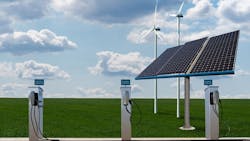Trucking sure is getting a lot of attention lately. There have been lots of new investments, with technology companies raising $10 million, $100 million, even $500 million. But the amounts aren't really what matter. What strikes me is that these investments are occurring at an ongoing pace, and they show no signs of stopping.
Last week I was in Las Vegas attending Manifest. The website for the show touts it this way: “Manifest Vegas brings together the most comprehensive ecosystem of innovation and transformation in supply chain and logistics.”
My interactions with people at the show got me thinking about the trucking industry—and the North American Council for Freight Efficiency’s work in it—in a broader way. Let me explain. We have technologies that can improve the efficiency of trucking today. Those are the things that we talk about in our Confidence Reports.
Then we have technologies that are a little further up the technology adoption S curve. This includes things like battery-electric vehicles, hydrogen fuel cell vehicles, and hybrid vehicles. Those are the things that we talk about in our Guidance Reports. They are things that are a little further out in the future but that we can still see coming into widespread use in the trucking industry in the not-too-distant future. And a little further out from that is autonomous trucking. It’s probably not as close as widespread adoption of zero-emission vehicles, but it is not so far in the future that it is the stuff of science fiction.
See also: Collaborating for a zero-emission future
But in addition to that, there is the stuff that is only now being imagined for the trucking industry. It is stuff that does not even appear on the S-curve of technology adoption because it has not been fully imagined.
Manifest got me thinking that there is something that comes before the innovators that adopt new technologies. And that is the people who are thinking up potential new products and solutions—some of which will work and some of which will fail and never see the light of day.
When you talk to people who make investments in ideas, you will find that they have a different mindset than most people about what constitutes success. When they make investments, they consider it a win if one out of 10 or even 20 of the ideas they invested in actually makes it to market. That boggles my mind, but I am also grateful to them because they are the ones who will continue to drive innovation in our industry.
I know a lot of people think that the move to a zero-emission transportation future is a big leap—and it undoubtedly is. But I left Manifest feeling like there will be more leaps in the future as we continue to strive to improve the way we move goods. And that was a great feeling.
Michael Roeth has worked in the commercial vehicle industry for nearly 30 years, most recently as executive director of the North American Council for Freight Efficiency (NACFE). He serves on the second National Academy of Sciences Committee on Technologies and Approaches for Reducing the Fuel Consumption of Medium and Heavy-Duty Vehicles and has held various positions in engineering, quality, sales, and plant management with Navistar and Behr/Cummins.
About the Author

Michael Roeth
Executive Director
Michael Roeth is the executive director of the North American Council for Freight Efficiency. He serves on the second National Academy of Sciences Committee on Technologies and Approaches for Reducing the Fuel Consumption of Medium and Heavy-Duty Vehicles and has held various positions with Navistar and Behr/Cummins.
